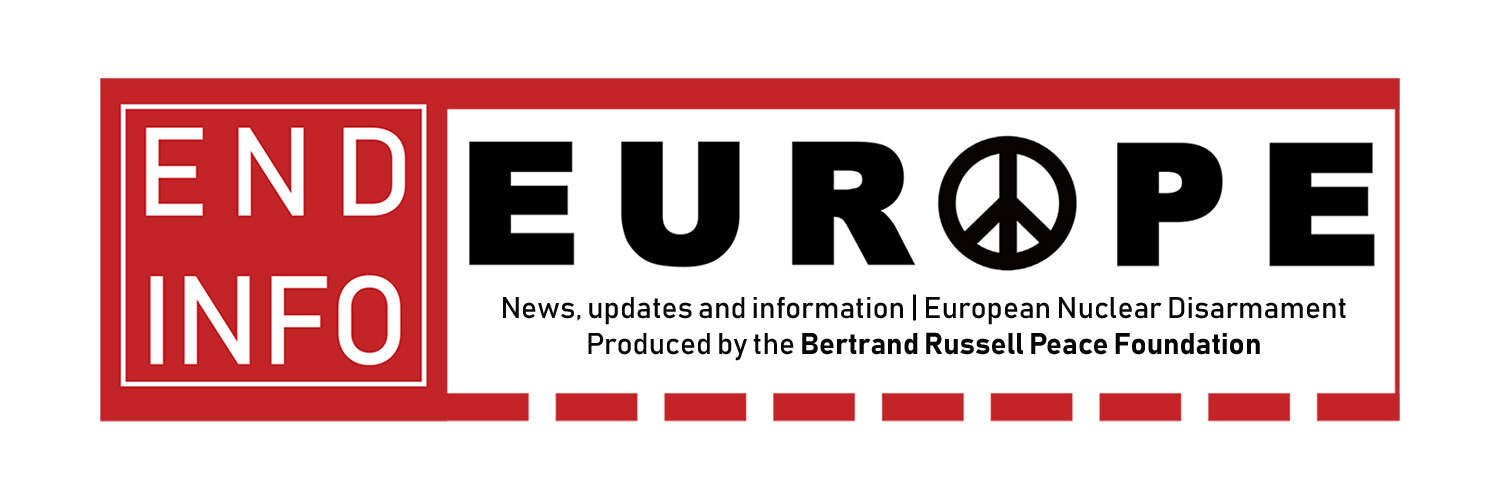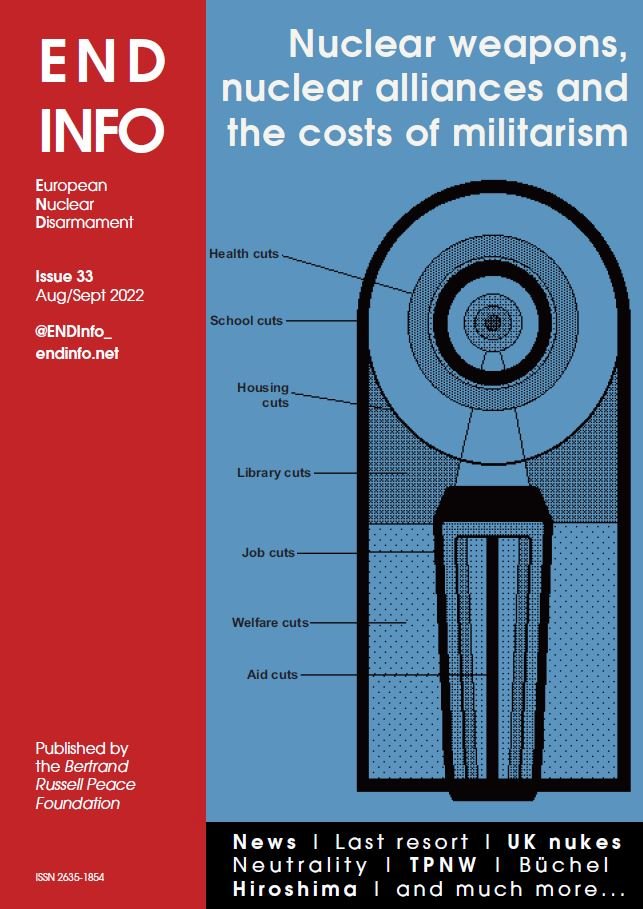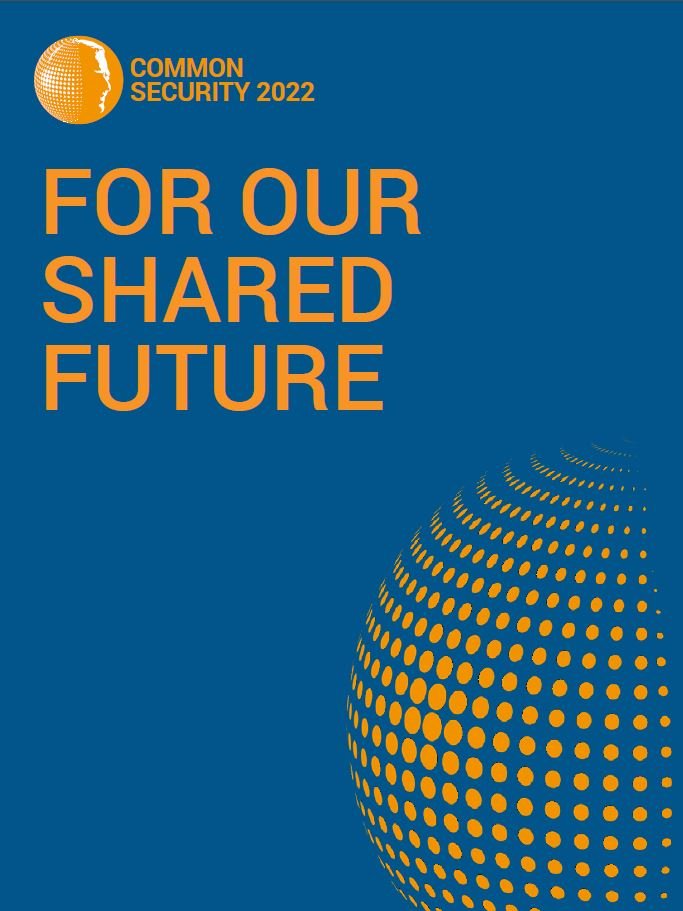All will lose
Tom Unterrainer, Editorial comments
From END Info 34 DOWNLOAD
“We affirm that a nuclear war cannot be won and must never be fought.” So proclaimed the leaders of the People’s Republic of China, the French Republic, the Russian Federation, the United Kingdom and the United States of America in a joint statement issued on 3 January, 2022. This statement, an echo of Reagan and Gorbachev from the ’80s, cannot be faulted. It is as self-evidently true in the 2020s as it was in the 1980s.
A nuclear war would kill millions in hours and could kill us all in time. The detonation of a single nuclear weapon by ‘accident’ or design could kill tens of thousands in an instant. Hundreds of thousands of corpses would surely follow. If such a war “must never be fought” in the reckoning of world leaders and of anyone with an ounce of common sense, why are so many resources dedicated to preparing nuclear annihilation? Why, in the months following the 3 January joint statement, have threats and counter-threats of nuclear war been issued with such reckless frequency?
Ken Coates notes in the introduction to his book, The Most Dangerous Decade (1984) that “Genocide is a crime”. He continues:
In order to be punished for it, hitherto, its instigators have had to lose a war. Since this happened in 1945, there have been recurrent acts which any impartial persons will regard as coming uncomfortably close to genocide. The United Nations Convention on Genocide defines the crime as an act committed with the intent to destroy, in whole or in part, a national, ethnic, racial or religious group. Article III of the Convention proclaims as punishable not only the act itself, but also conspiracy to commit it, incitement to it, attempts to perform it, and complicity in it. Article IV specifically insists that punishment applies to rulers, public officials and private individuals ...
It is, of course, assumed by Governments that preparation for nuclear war does not constitute conspiracy to prepare genocide. In Britain, those who physically resist the installation of weapons of mass-obliteration are normally charged with the offence of “breaching the peace”, however pacific their protests may be shown to have been ...
There will, however, be no Nuremberg Tribunal to order the execution of the losers in the next war. All will lose, and among any survivors laws of any kind will be part of the same poisonous ruins as the material artifacts of civilisation. The most optimistic predictions about that war assume regression on a total scale, worse prospects are commonly anticipated. It is by no means outside the technical scope of modern armourers to render the entire planet uninhabitable by people of any kind.
Not only are these things widely understood: they have penetrated people’s minds in an insidious way, alongside the realisation that conscience, in the world which plans for holocaust, is itself an outlaw. As a result, authority all-too-easily overrides it. People in the main value order, and social harmony, however conscious they may be of injustice or institutional wrongs.
END Info has previously reported upon and roundly condemned nuclear threats issued by the Russian President. In February and March, 2022, the Bertrand Russell Peace Foundation issued statements warning that the whole of “Europe is at evident risk of becoming ... a battlefield - even a nuclear one” (25/02/2022). Three days later, we warned that “[I]n breaking the nuclear taboo, Putin exposes the duplicity of nuclear ‘deterrence’, which really means threatening megadeath” and went on to ask: “Who will provide a ladder for Putin to climb down?” (28/02/2022). In early March we noted that Putin’s ‘deterrence’ “flips to ‘escalate to de-escalate’” and asked: “Where does that end?”
Russian officials have claimed that their nuclear threats were met with similar threats from the United States. Until recently, President Biden and his spokespeople have not issued such public threats. This has now changed.
In an essay for The New York Times May, 2022, President Biden warned that “any use of nuclear weapons in this conflict on any scale would be completely unacceptable to us as well as the rest of the world and would entail severe consequences.” He did not spell out what those consequences would be.
In comments made at the end of September, 2022, Jake Sullivan - Biden’s national security adviser - revealed that the US had warned Russia of “catastrophic consequences” in the event of nuclear use. The New York Times describes Sullivan as “a longtime student of nuclear escalation risks, and he has been walking a fine line between orchestrating repeated warnings to the Russians and avoiding statements that could prompt Moscow to raise the stakes, perhaps by beginning to move weapons toward the border in a menacing show of seriousness” (25/09/22). The paper goes on to explain that Sullivan reiterated his claims on national television, where he explained that: “We have communicated to the Russians what the consequences would be ... but we’ve been careful in how we talk about this publicly, because from our perspective we want to lay down the principle that there would be catastrophic consequences, but not engage in a game of rhetorical tit for tat.”
There can, of course, be no excuse for making nuclear threats of any kind, at any time or in any circumstance. As we have established, such threats constitute a threat of mass death and genocide. However, despite Mr Sullivan’s stated reluctance to “engage in a game of rhetorical tit for tat” it appears that this is exactly what he, his bosses and their Russian counterparts have been doing.
In the first week of October, 2022, President Biden used the platform at a Democratic Party fundraising event to issue a chilling warning to the world. According to reports in The Guardian (London) on 7 October, 2022, Biden said:
“We have not faced the prospect of Armageddon since Kennedy and the Cuban missile crisis ...
We’ve got a guy I know fairly well ... [Putin’s] not joking when he talks about potential use of tactical nuclear weapons or biological or chemical weapons because his military is, you might say, significantly underperforming ...
I don’t think there’s any such thing as the ability to easily (use) a tactical nuclear weapon and not end up with Armageddon...
First time since the Cuban missile crisis, we have the threat of a nuclear weapon if in fact things continue down the path they are going...
We are trying to figure out what is Putin’s off-ramp? Where does he find a way out?”
Putin and Russia certainly need an “off-ramp”, or as the Russell Foundation put it in February, “a ladder to climb down”, but rather than solely focus on reducing nuclear tensions in order for such a settlement to be reached, we witness the trading of nuclear threats. Rather than actually attempting to reduce the prospects of mass death, nuclear genocide or, in Biden’s own words, “Armageddon”, we see the stoking of nuclear tensions.
Rather than deal with the immediate nuclear threats and tensions what Putin, Biden and the pundits, journalists and ‘analysts’ who have speculated on how one side or the other will react in the event of nuclear use have done is to normalise the use of nuclear weapons. There is now a large-scale appreciation of existing and growing nuclear threats but this appreciation has not been met with widespread understanding of what this all means. This process of ‘normalisation’ is an effort to make the obscene, the grotesque, the catastrophic and the murderous implications of nuclear weaponry appear an acceptable part of political discourse.
What fate has diplomacy suffered? Where are the negotiations? Where is the consistent, honest and open commitment to some form of peaceful settlement to the desperate situation in Ukraine from the nuclear powers? Where is the recognition that ‘security’ cannot be guaranteed by nuclear weapons, nuclear alliances and the threat of mass destruction? As we argued in the last issue of END Info (Issue 33):
The sharpening tensions arising from Putin’s invasion of Ukraine - including the stark nuclear tensions - put us all at risk. Yet the response of NATO is unlikely to reduce the tensions, nuclear or otherwise. In fact, such responses follow a pattern we have seen in the past and will undoubtedly replicate the worst possible consequences.
Nuclear weapons, nuclear alliances
and the costs of militarism
We argued further that:
If, for NATO, every problem is a nail, then the biggest hammer at its disposal is the nuclear weapon ...
A truly secure future must mean working for peaceful outcomes to these challenges, not preparing for war.
Further justification for these warnings was provided in President Biden’s new National Security Strategy (October 2022). In his introduction to the NSS Biden writes:
Around the world, the need for American leadership is as great as it has ever been. We are in the midst of a strategic competition to shape the future of the international world order ...
We have also reinvigorated America’s unmatched network of alliances and partnerships to uphold and strengthen the principles and institutions that have enabled so much stability, prosperity, and growth for the last 75 years.
On page 38 of the NSS, in a section titled ‘Deepen Our Alliance with Europe’, we read:
With a relationship rooted in shared democratic values, common interests, and historic ties, the transatlantic relationship is a vital platform on which many other elements of our foreign policy are built. Europe has been, and will continue to be, our foundational partner in addressing the full range of global challenges. To effectively pursue a common global agenda, we are broadening and deepening the transatlantic bond - strengthening NATO, raising the level of ambition in the U.S.-EU relationship, and standing with our European allies and partners in defense of the rules-based system that underpins our security, prosperity, and values ... America remains unequivocally committed to collective defense as enshrined in NATO’s Article 5 and will work alongside our NATO Allies to deter, defend against, and build resilience to aggression and coercion in all its forms. As we step up our own sizable contributions to NATO capabilities and readiness - including by strengthening defensive forces and capabilities, and upholding our long-standing commitment to extended deterrence - we will count on our Allies to continue assuming greater responsibility by increasing their spending, capabilities, and contributions. European defense investments, through or complementary to NATO, will be critical to ensuring our shared security at this time of intensifying competition.
The world awaits the publication of the Biden administrations much-delayed Nuclear Posture Review, which deals with specifics of nuclear doctrine, but the direction of travel seems clear. What this will mean is that rather than attempt to create alternative, common security policies to ensure that war and the prospect of nuclear war is averted, the existing dynamic of tension and power politics will be reinforced: the threat of nuclear war will be increased.
To avert such prospects, it is essential that nuclear tensions are drastically reduced. This should be the number one priority of all governments, but special responsibility lies with the nuclear armed states. First and foremost, this means jettisoning any and all nuclear threats with immediate effect. Second, it means engaging in real and meaningful diplomacy to resolve the war in Ukraine. Third, it means adopting alternative approaches to security based on the idea that the security of one state cannot be achieved at the expense of another.
Achieving all of this is no easy task. Humanity faces manifold and interconnected crises. Each one of these crises, from climate emergency to falling living standards, is driven by a system that is incapable of addressing, let alone solving, the terrible effects. Worse still, the systems’ attempts to address pressing needs often exacerbate the situation. Take, for example, Prime Minister Truss’ now-aborted plans to tackle the energy price crisis. If we take her at her word, the whole point of the disastrous mini-budget was to protect the British population from excessive energy bills over a two year period. The result? Chaos. In an effort to resolve this chaos, a new Chancellor of the Exchequer looks set to impose yet more austerity on the nation. The result? More suffering. Only a very different approach will ensure an end to chaos and an end to suffering.
The dominant approaches to questions of ‘defence’ and ‘security’ suffer in the same respect. The words ‘defence’ and ‘security’ should be used with great caution for any number of reasons but the clearest example is given by the part played by nuclear weapons in Britain’s military posture. The Johnson government’s 2021 Integrated Review – Global Britain in a competitive age – makes the following claim for Britain’s nuclear weapons: they “deter the most extreme threats to our national security and way of life, helping to guarantee our security and that of our Allies”. NATO’s most recent strategic concept, released in 2022, claims: “The strategic nuclear forces of the Alliance, particularly those of the United States, are the supreme guarantee of the security of the Alliance … NATO’s nuclear deterrence [sic] posture also relies on the United States’ nuclear weapons forward-deployed in Europe and the contributions of Allies concerned.” Britain is, of course, a member of NATO.
So, according to the British government and its NATO allies, ‘defence’ and ‘security’ are ultimately guaranteed by machines designed to unleash megadeath. Not only is this a foul and repugnant idea in and of itself, but it is outlandish in the extreme. Yet a publicly stated willingness to ‘press the button’ and kill millions is a shibboleth uttered by all those seeking high office, with one notable exception. Why is this idea ‘outlandish’? Imagine the reaction if all our politicians insisted that euthanasia be used as a cure for the troubles of old age? Killing millions of people, or threatening to do so, is not a credible solution to anything. Worse, it is criminal.
The majority of the world does not possess nuclear weapons and is not incorporated into nuclear alliances, like NATO. A growing number of states, particularly in the Global South, have mounted a full-frontal rejection of ‘nuclearism’ by either signing or ratifying the United Nations Treaty on the Prohibition of Nuclear Weapons. There is a growing recognition outside of Europe and America that the problems faced by the whole of humanity – be they nuclear threats, climate catastrophe, hunger, displacement or insecurity – cannot be addressed at the expense of others. Global problems require global solutions and these can only be reached by cooperation and a common approach.
In the face of this growing recognition, Britain and its allies are resorting to militarised responses and an expansionary approach. CND’s recent conference labelled this approach as one “based on threat and force rather than collective problem solving and peaceful even development.” Conference went on to agree that “This is particularly marked in the nuclear weapons sphere. On top of the ongoing replacement of the Trident nuclear weapons system, we have seen the nuclear arsenal increase, the expansion of the nuclear use policy, the withdrawal of transparency, the adoption of the AUKUS agreement, and most recently the return of US/NATO nuclear weapons to RAF/USAF Lakenheath”.
The Truss government committed itself to increased military spending, which will only mean more of the same. Will Rishi Sunak uphold this commitment? It seems likely.
As the social and economic conditions for large parts of the population spiral downwards, as poverty and insecurity stalk the land, as the health services remain underfunded and working people face pay cuts this government and others like it across Europe pledge further billions to military spending.
People cannot eat missiles. Warships cannot cure disease. Tanks cannot home the homeless. Fighter aircraft will not care for the needy. Chemical and biological weapons will not educate our children. Nuclear weapons cannot ensure security.
Adapted and expanded from ‘Killing millions of people is not a credible solution to anything’, which appeared in the Morning Star on Thursday 20 October 2022.






















